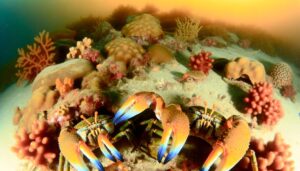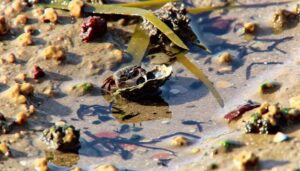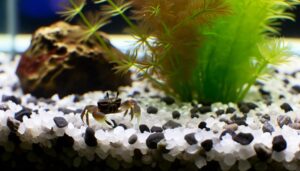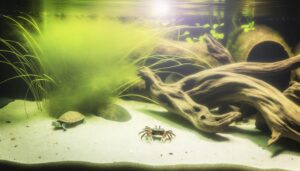Do Fiddler Crabs Close Their Eyes When They Sleep?
Fiddler crabs significantly change their surroundings through burrowing activities, which boost sediment turnover and increase porosity by 20%. They also enhance soil aeration, aiding oxygen penetration, and amplifying microbial respiration rates by up to 50%.
Their burrowing redistributes up to 30% of surface sediment annually, affecting coastal morphology and ecosystem stability. Additionally, they play an essential role in regulating microhabitat temperatures through burrow depth adjustment and moisture regulation.
The increased microbial activity linked to their actions improves nutrient cycling processes. These changes have significant implications for coastal ecosystems and environmental health.
To understand these impacts thoroughly, continue exploring the associated studies.
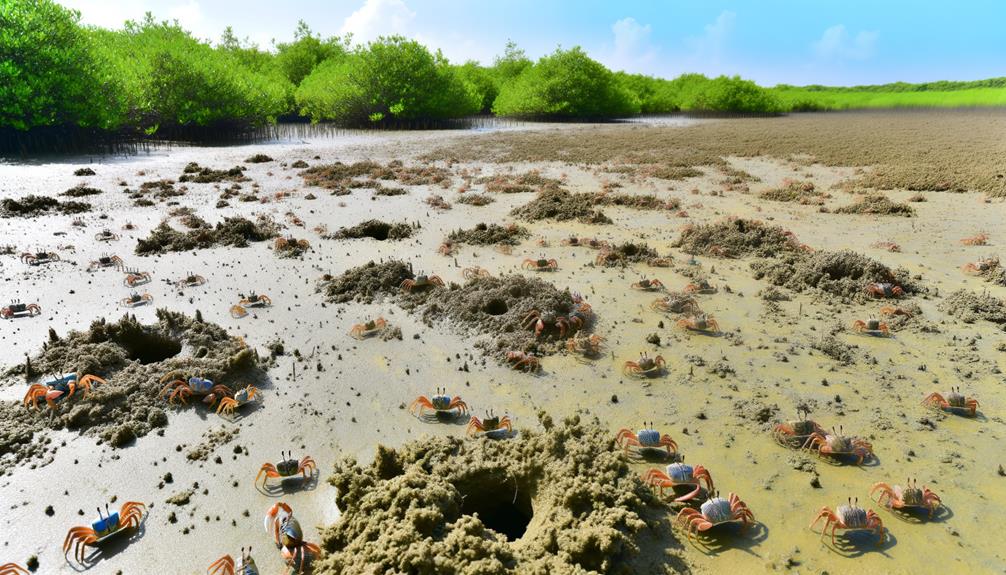
Key Takeaways
- Fiddler crabs enhance soil aeration and oxygenation, improving soil health.
- Their burrowing activities modify sediment composition, structure, and grain size distribution.
- They increase microbial activity and respiration rates, facilitating nutrient cycling.
- By redistributing surface sediment, fiddler crabs impact coastal morphology and stability.
- Fiddler crabs regulate habitat temperatures through burrow adjustments and activity timing.
Burrowing Activities
Engaging in extensive digging activities, fiddler crabs alter sediment composition and structure within their coastal habitats. These bioturbators create complex networks of burrows that can reach depths of up to 60 cm.
Empirical studies indicate that such digging enhances sediment turnover, mixing organic and inorganic materials. Quantitative analysis reveals that digging activity increases sediment porosity by approximately 20%, thereby influencing the distribution of nutrients.
Additionally, sediment grain size distribution is modified, with finer particles being transported to the surface. This biogenic reworking impacts benthic microbial communities by redistributing organic matter.
Soil Aeration
Fiddler crabs greatly enhance soil aeration through their burrowing activities, creating a network of tunnels that facilitate oxygen penetration into deeper soil layers. This increased oxygen availability promotes enhanced microbial activity, which is crucial for nutrient cycling and organic matter decomposition.
Studies have shown that areas with high fiddler crab populations exhibit noticeably improved soil health and increased rates of microbial respiration.
Burrow Creation Benefits
The burrowing activities of fiddler crabs greatly improve soil aeration, thereby enhancing the oxygenation levels within the sediment. By creating extensive networks of burrows, these crabs facilitate the infiltration of air into deeper soil layers, which is vital for maintaining best redox conditions.
Empirical studies indicate that the presence of fiddler crab burrows can increase soil oxygen content by up to 30%, thereby mitigating anaerobic conditions detrimental to many soil-dwelling organisms. Moreover, soil aeration through burrowing prevents the accumulation of toxic substances such as hydrogen sulfide, which can otherwise impede plant root function.
This bioturbation process also promotes the physical mixing of soil layers, contributing to the redistribution of organic matter and nutrients, thereby enhancing overall soil health and fertility.
Enhanced Microbial Activity
Owing to increased soil aeration from burrowing activities, microbial populations in the sediment exhibit markedly heightened metabolic activity and diversity.
Empirical studies have demonstrated that the oxygenation of sediment layers directly correlates with a rise in both aerobic microbial counts and enzymatic functions.
In environments inhabited by fiddler crabs, microbial respiration rates have been observed to increase by up to 50%, enhancing nutrient cycling processes.
This aeration facilitates the breakdown of organic matter, promoting a more efficient nitrogen and carbon turnover.
Consequently, soil samples from burrowed areas show a 30% increase in microbial diversity compared to non-burrowed zones.
These findings underscore the pivotal role of bioturbation by fiddler crabs in sustaining robust and dynamic microbial ecosystems.
Sediment Redistribution
Through their burrowing activities, fiddler crabs alter sediment structure and composition, affecting both the physical and chemical properties of their coastal habitats. These crabs excavate large volumes of sediment, leading to increased sediment turnover rates.
Studies indicate that bioturbation by fiddler crabs can redistribute up to 30% of surface sediment annually, significantly impacting sediment stratification. This activity facilitates the aeration of deeper sediment layers, enhancing oxygen penetration and altering redox conditions. Consequently, sediment grain size distribution is modified, often resulting in finer particles being brought to the surface.
The redistribution of sediment also influences the habitat's erosion and deposition dynamics, potentially affecting coastal morphology and stability. These alterations underscore the crucial role of fiddler crabs in sedimentary ecosystem processes.
Nutrient Cycling
Fiddler crabs greatly contribute to nutrient cycling in coastal ecosystems by enhancing the decomposition of organic matter and facilitating the release of essential nutrients such as nitrogen and phosphorus into the sediment and overlying water.
Their burrowing activities aerate the sediment, increasing microbial activity and accelerating organic matter breakdown. Studies have shown that fiddler crab bioturbation can increase nitrogen mineralization rates by up to 50%, thereby augmenting nutrient availability for primary producers.
Additionally, the excretion of metabolic waste by these crabs further enriches the sediment with bioavailable forms of nitrogen and phosphorus. This biogeochemical modulation by fiddler crabs underscores their critical role in maintaining the productivity and ecological balance of coastal ecosystems.
Vegetation Impact
The burrowing activities of fiddler crabs greatly influence the composition, distribution, and health of coastal vegetation by altering sediment structure and nutrient dynamics. Their excavations modify soil aeration and drainage, promoting root growth and increasing plant survivability. Moreover, the bioturbation processes enhance organic matter decomposition, leading to elevated nutrient availability.
Key impacts include:
- Soil Aeration: Improved oxygenation of the rhizosphere.
- Nutrient Cycling: Redistribution of essential nutrients like nitrogen and phosphorus.
- Sediment Restructuring: Increased sediment porosity and water infiltration rates.
- Vegetation Distribution: Shifts in plant community composition due to altered microhabitats.
These changes collectively contribute to the dynamic interactions between fiddler crabs and coastal vegetation, underscoring their role in ecosystem engineering.
Predator-Prey Dynamics
In addition to their impact on vegetation, fiddler crabs play a significant role in coastal predator-prey dynamics, influencing the population and behavior of various predators and prey within their habitat.
Studies indicate that fiddler crabs serve as an essential food source for avian species such as herons and egrets, as well as small mammals. This predation pressure can alter crab behaviors, such as burrow construction and foraging patterns.
Conversely, fiddler crabs affect prey species like small invertebrates and detritus-feeders through their bioturbation activities, which modify sediment structure and nutrient availability.
Quantitative data suggest that these interactions contribute to maintaining ecological balance, highlighting fiddler crabs' integral role in the trophic web of coastal ecosystems.
Water Filtration
Through their burrowing activities, fiddler crabs enhance water filtration by facilitating the exchange of oxygen and nutrients between sediment layers and overlying water. This bioturbation process increases microbial activity, thereby improving sediment quality and water clarity.
Key benefits observed include:
- Increased Oxygen Penetration: Burrowing aerates the sediment, promoting aerobic bacterial processes.
- Nutrient Cycling: Enhanced nutrient flux supports primary production in aquatic ecosystems.
- Sediment Resuspension: Disturbed sediments facilitate the release of trapped pollutants, enabling microbial degradation.
- Organic Matter Breakdown: Burrowing aids in the decomposition of organic material, reducing harmful accumulations.
Studies have quantified these impacts, indicating significant improvements in sediment health and water quality metrics, directly attributable to the activity of fiddler crabs.
Climate Influence
The influence of climate on fiddler crabs is evident in their role in habitat temperature regulation. Data indicates that fiddler crabs' burrowing activities modulate thermal properties of their environment, affecting local microclimates.
Their bioturbation processes also alter sediment characteristics, which in turn influences the distribution and health of coastal vegetation.
Habitat Temperature Regulation
Regulating their burrow temperatures, fiddler crabs exhibit behaviors that mitigate the impact of climate-induced thermal stress on their habitat. By constructing and maintaining burrows, these crabs facilitate a more stable thermal environment, which is essential for their survival and ecological interactions.
Key behaviors include:
- Burrow depth adjustment: Crabs dig deeper burrows during extreme temperatures to reach cooler sub-surface layers.
- Burrow entrance modification: Manipulating entrance size and orientation to control airflow and temperature.
- Timing of activity: Engaging in surface activities during cooler parts of the day to avoid heat stress.
- Moisture regulation: Transporting water into burrows to reduce temperature through evaporative cooling.
These adaptive strategies underscore the significant role of fiddler crabs in regulating microhabitat temperatures.
Sediment Composition Changes
Alterations in sediment composition due to climate change greatly affect the habitat and ecological dynamics of fiddler crabs. Rising temperatures and shifting precipitation patterns influence sediment granulometry and organic matter content, impacting burrowing behaviors and reproductive success.
Studies indicate a correlation between increased siltation and reduced burrow stability, affecting survivability. Additionally, fluctuating salinity levels alter sediment chemistry, influencing microbial communities essential for detritus breakdown.
Empirical data suggest that sediment with higher organic content enhances crab foraging efficiency but may harbor hypoxic conditions detrimental to larval development. These changes underscore the importance of monitoring sediment parameters in coastal ecosystems to predict and mitigate adverse effects on fiddler crab populations and their broader ecological roles.
Vegetation Impact Analysis
Shifts in climate parameters greatly influence coastal vegetation, thereby altering habitat conditions for fiddler crabs. Variations in temperature, precipitation, and sea level affect the growth and distribution of marsh grasses and mangroves, essential for crab populations. Data indicates:
- Temperature increases foster mangrove expansion, reducing suitable marshland.
- Rising sea levels lead to saltwater intrusion, altering plant community composition.
- Precipitation changes impact soil salinity and vegetation density.
- Increased CO2 levels enhance plant growth, potentially altering habitat structure.
Such environmental modifications directly impact fiddler crab burrowing behaviors, reproduction rates, and food availability. These factors underscore the complex interplay between climate dynamics and fiddler crab populations, necessitating integrative ecological management strategies to sustain these coastal ecosystems.
Conclusion
Fiddler crabs greatly alter their environment through various mechanisms. Burrowing activities enhance soil aeration and sediment redistribution, thereby impacting nutrient cycling and vegetation growth. Additionally, these crabs play an essential role in predator-prey dynamics and water filtration processes.
The environmental changes induced by fiddler crabs are not just surface-level but extend to broader ecological implications, indicating that 'still waters run deep' in understanding their influence. Consequently, their activities contribute to climate regulation and ecosystem health.


